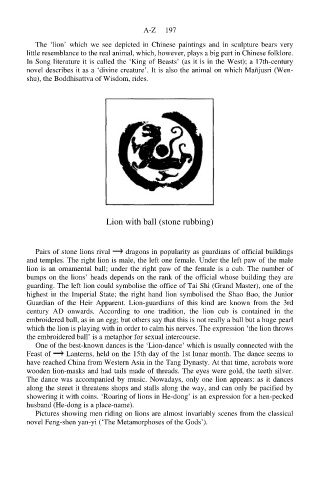Page 204 - A Dictionary of Chinese Symbols BIG Book
P. 204
A-Z 197
The ‘lion’ which we see depicted in Chinese paintings and in sculpture bears very
little resemblance to the real animal, which, however, plays a big part in Chinese folklore.
In Song literature it is called the ‘King of Beasts’ (as it is in the West); a 17th-century
novel describes it as a ‘divine creature’. It is also the animal on which Mañjusri (Wen-
shu), the Boddhisattva of Wisdom, rides.
Lion with ball (stone rubbing)
Pairs of stone lions rival dragons in popularity as guardians of official buildings
and temples. The right lion is male, the left one female. Under the left paw of the male
lion is an ornamental ball; under the right paw of the female is a cub. The number of
bumps on the lions’ heads depends on the rank of the official whose building they are
guarding. The left lion could symbolise the office of Tai Shi (Grand Master), one of the
highest in the Imperial State; the right hand lion symbolised the Shao Bao, the Junior
Guardian of the Heir Apparent. Lion-guardians of this kind are known from the 3rd
century AD onwards. According to one tradition, the lion cub is contained in the
embroidered ball, as in an egg; but others say that this is not really a ball but a huge pearl
which the lion is playing with in order to calm his nerves. The expression ‘the lion throws
the embroidered ball’ is a metaphor for sexual intercourse.
One of the best-known dances is the ‘Lion-dance’ which is usually connected with the
Feast of Lanterns, held on the 15th day of the 1st lunar month. The dance seems to
have reached China from Western Asia in the Tang Dynasty. At that time, acrobats wore
wooden lion-masks and had tails made of threads. The eyes were gold, the teeth silver.
The dance was accompanied by music. Nowadays, only one lion appears: as it dances
along the street it threatens shops and stalls along the way, and can only be pacified by
showering it with coins. ‘Roaring of lions in He-dong’ is an expression for a hen-pecked
husband (He-dong is a place-name).
Pictures showing men riding on lions are almost invariably scenes from the classical
novel Feng-shen yan-yi (‘The Metamorphoses of the Gods’).

